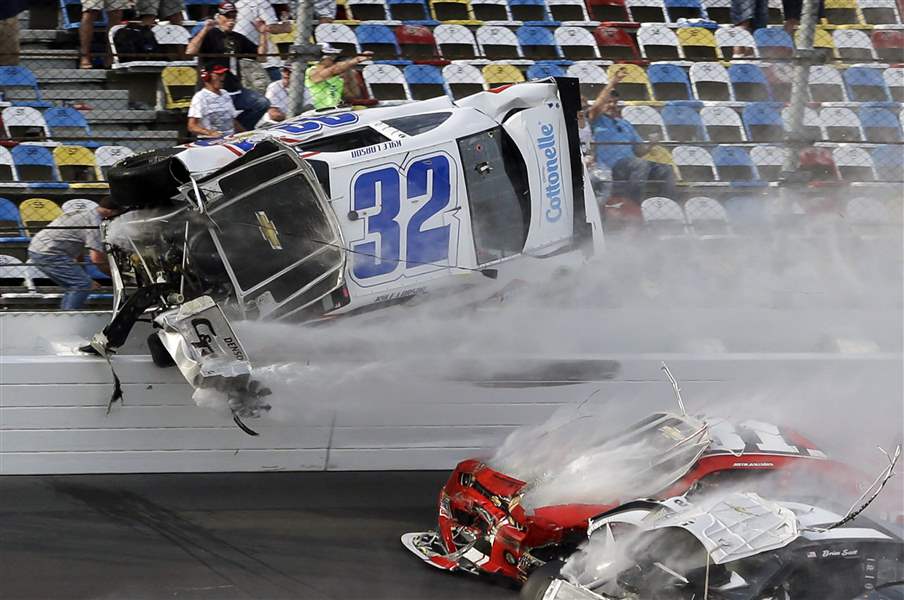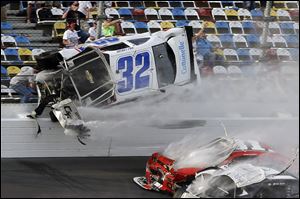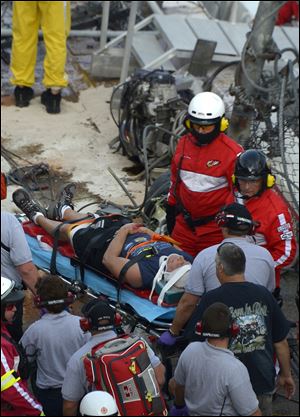
NASCAR safety in stands under spotlight
MIS officials assure precautionary measures are in place
3/4/2013
Kyle Larson (32) goes airborne and into the catch fence during a multi-car crash involving Justin Allgaier (31), Brian Scott (2) and others during the final lap of the NASCAR Nationwide Series race Feb. 23 at Daytona International Speedway in Daytona Beach, Fla. Larson's crash sent car parts and other debris flying into the stands injuring spectators.
ASSOCIATED PRESS

Kyle Larson (32) goes airborne and into the catch fence during a multi-car crash involving Justin Allgaier (31), Brian Scott (2) and others during the final lap of the NASCAR Nationwide Series race Feb. 23 at Daytona International Speedway in Daytona Beach, Fla. Larson's crash sent car parts and other debris flying into the stands injuring spectators.
Jimmie Johnson doesn’t believe NASCAR’s drivers should change the way they race. In the wake of a crash that injured 28 spectators at a Nationwide Series race on Feb. 23 at Daytona International Speedway, the reigning Sprint Cup Series champion believes that in order to further improve the safety of spectators at NASCAR tracks, it will require the collaboration of NASCAR officials, track officials, and drivers alike.
“When you look at the proximity of where fans sit near the racetrack, there’s certain elements of our sport that are dangerous,” said Johnson, who won this year’s Daytona 500. “We need to look at all things right now. Unfortunately, it’s just a fluke accident that kind of opened everyone’s mind to have them look at this.”
Spectators at the fourth turn of the Daytona grandstand suffered injuries after Kyle Larson’s Chevrolet crashed into a barrier and littered pieces of the car in the seats, including a tire that landed on a seat next to a spectator and the Chevrolet’s engine block that landed in the catch fencing, only a few feet from grandstand seating.
“We were prepared [Saturday], had emergency medical response,” Joie Chitwood, Daytona’s track president, told the pool of reporters Feb. 24. “As we learn from this, you bet, if there are things that we can incorporate in the future, whether it’s the current property now or any other redevelopment, we will.”
Roger Curtis, the president of Michigan International Speedway, considered precautionary measures already in place at the Brooklyn, Mich., super speedway in relation to track configuration, track personnel and emergency protocol — the same plans, he said, that are in place at Daytona. Daytona and MIS are two of 12 tracks owned by International Speedway Corporation, based in Daytona Beach, Fla.
“All the tracks have great safety measures, including the catch fences,” Curtis said. “We continually have structural engineers looking at the fencing and bringing recommendations to us, and as far as safety, I feel very good about the measures we have in place.”
Curtis explained that safety measures at MIS include housing police, medical, and public safety officials in an emergency control center on race weekends, coordinating a network of track officials and NASCAR officials, keeping emergency medical personnel on hand, and working with the National Weather Service in the event of lightning strikes, storms or tornadoes.
“We are always prepared and do walk-throughs before every race each year to make sure everyone is on board,” Curtis said. “We have it there, and you hope you never, ever have to put it in place. You have to be prepared. The number-one priority is fan safety.”
The Daytona accident is believed to be the largest number of fans injured in a NASCAR race-related accident, and the incident came nearly four years after eight fans were injured at Talladega Superspeedway when Carl Edwards’ car flew into the catchfence at the track.

Emergency officials transport an injured spectator past Kyle Larson's engine after a crash on the final lap of the NASCAR Nationwide Series race Feb. 23 at Daytona International Speedway.
In 1999, a tire and suspension debris killed three fans at an IndyCar race at Charlotte Motor Speedway and a year earlier, three spectators were killed and five injured in an accident at MIS.
Two-thirds of the way through the Championship Auto Racing Teams U.S. 500 on July 26, 1998, debris from a wrecked race car flew over a wall and into the MIS stands. Adrian Fernandez slid upwards into the wall on the track’s fourth turn and the right front tire and pieces of the suspension of his car broke off and went into the stands.
“It was a very violent crash,” Fernandez told the Blade after the 1998 race. “It was unbelievable how hard it hit. It was a massive hit.”
The race continued, but drivers and teams at the time were not aware of how serious the effect of the accident was.
At the time, CART chairman and CEO Andrew Craig said all 19 tracks in the now-defunct racing series underwent annual safety inspections and in the wake of the accident, former MIS owner Roger Penske instituted improvements to the facility, including additional fencing in front of spectator areas and additional support posts and cabling.
“With it being a Penske track back then, and from the folks I’ve talked to, [track officials] responded the very same way,” said Curtis, who worked at Watkins Glen (N.Y.) International at the time of the CART accident. “They brought in experts, engineers, and worked on what they could do to improve the facility and the fencing.
"They made quite a few improvements to the catch fence, and I’m sure they will again. Now, it’s going to take a bit to analyze the information they’ll be going through.”
The Daytona Beach (Fla.) News-Journal reported Feb. 26 that NASCAR and Daytona International Speedway officials plan to conduct an investigation into the crash, and that there would be no involvement by a government or public agency.
NASCAR senior vice president Steve O’Donnell said Daytona International Speedway will also bring in an outside firm as part of an investigation.
The News-Journal also reported that seven injured spectators are exploring possible litigation. NASCAR, per SEC filings, requires tracks to have $50 million in insurance to cover spectator injuries.
“It was definitely a freak accident,” Curtis said. “I don’t know if we’ll ever see it again, but you never know. But with the safety measures that NASCAR has in place, 99.9 percent of those worked. The car did not go into the stands, the engine got tangled in the catch fence and did not go any further. But that something that will be looked at.
“This is a major incident, but there are minor incidents that we look at also, on a daily basis. And that process never, ever stops. Those are priorities when it comes to fans.”
Contact Rachel Lenzi at: rlenzi@theblade.com, 419-724-6510 or on Twitter @RLenziBlade.